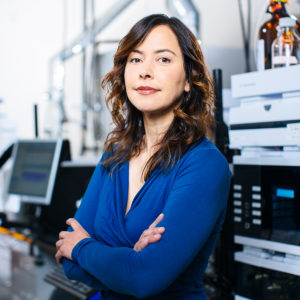Researchers report the first successful microbial biosynthesis of the tropane alkaloids hyoscyamine and scopolamine, a class of neuromuscular blockers naturally found in plants in the nightshade family.

Describing a first-in-class fermentation-based approach for producing complex molecules, the paper lays the foundation for a controlled, flexible, cell-based manufacturing platform for essential medicines that currently rely on crop farming, according to research leader Christina Smolke, PhD, professor of bioengineering at Stanford University and CEO and co-founder of Antheia, a synthetic biology company making next-generation plant-inspired medicines.
The tropane alkaloids hyoscyamine and scopolamine are used in treating neuromuscular disorders such as Parkinson’s, intestinal disorders, and other issues caused by muscle spasms. Currently, the global supply of these medicinal tropane alkaloids relies on intensive cultivation of nightshade plants, as direct chemical synthesis of these medical agents is not commercially viable.
As a result, this class of drugs is subject to global supply risks. The current agricultural-based supply chain coupled with increasing demand has resulted in recurring shortages of tropane alkaloid-based medicines, such as atropine, an antimuscarinic agent used to reduce salivation before surgery, and transdermal scopolamine patches used to prevent nausea and vomiting.
The team published its study, “Biosynthesis of medicinal tropane alkaloids in yeast,” in Nature.
“Tropane alkaloids from nightshade plants are neurotransmitter inhibitors that are used for treating neuromuscular disorders and are classified as essential medicines by the World Health Organization. Challenges in global supplies have resulted in frequent shortages of these drugs,” the investigators wrote.
“Further vulnerabilities in supply chains have been revealed by events such as the Australian wildfires and the COVID-19 pandemic. Rapidly deployable production strategies that are robust to environmental and socioeconomic upheaval are needed.
“Here we engineered baker’s yeast to produce the medicinal alkaloids hyoscyamine and scopolamine, starting from simple sugars and amino acids. We combined functional genomics to identify a missing pathway enzyme, protein engineering to enable the functional expression of an acyltransferase via trafficking to the vacuole, heterologous transporters to facilitate intracellular routing, and strain optimization to improve titers.
“Our integrated system positions more than twenty proteins adapted from yeast, bacteria, plants, and animals across six sub-cellular locations to recapitulate the spatial organization of tropane alkaloid biosynthesis in plants. Microbial biosynthesis platforms can facilitate the discovery of tropane alkaloid derivatives as new therapeutic agents for neurological disease and, once scaled, enable robust and agile supply of these essential medicines.”
“This paper is an exciting breakthrough for the pharmaceutical industry and a positive signal for the next phase of growth in synthetic biology,” said Smolke. “Publishing our efforts to produce complex molecules like tropane alkaloids is a critical proof point for realizing an advanced manufacturing model that offers greater efficiency, consistency, and quality in global medicine production.
“Beyond the potential impact on pharma, the ability to functionally express, integrate, and orchestrate genetic and biochemical functions across kingdoms and species will help realize synthetic biology’s promise across several industries and applications.”
Since the inception of synthetic biology, efforts have abounded to use microbial hosts like yeast to produce a diversity of chemicals, with most successful demonstrations applied to compounds that require the introduction of limited numbers of non-native genes. To date, microbial biosynthesis has been demonstrated for a limited number of relatively simple medicinal compounds, including antimalarials and cannabinoids.
One of the key challenges in reconstructing more complex plant-based biosyntheses in microbes is that plants have evolved extensive strategies for spatially distributing enzymes (and associated chemistries) across cellular compartments, cell types, and even tissues, strategies that cannot be readily recapitulated in single-cell yeast.
The full reconstruction of tropane alkaloid biosynthesis in yeast presented in this paper is the most advanced example of a microbial cell factory to date, requiring the functional expression and integration of 26 genes from 10 different organisms (across 4 kingdoms) and 8 gene deletions. The resulting whole-cell system expresses enzymes and transporters across every yeast organelle to truly re-envision the cell as a factory for efficiently assembling the most complex molecules known to humankind.
The tropane alkaloids are the latest category of highly complex plant-based medicinal compounds Smolke’s lab has produced via yeast fermentation. Smolke’s earlier pioneering work demonstrated the biosynthesis of another class of plant-based medicines (benzylisoquinoline alkaloids), and this paper further highlights the flexibility and power of brewer’s yeast as a platform for synthesizing the most valuable and complex molecules.
This whole-cell bioengineering approach to biosynthesis underlies Smolke’s work both in her Stanford lab and at Antheia, which brings together functional genomics, protein engineering, and strain optimization to enable on-demand and at-scale production of plant-inspired medicines, and to dramatically expand the possibilities for discovering new medicines.
“This study is setting new standards for how yeast can be recruited for production of complex plant natural products,” said Jens Nielsen, PhD, professor of systems biology, Chalmers University of Technology, Sweden. “Assembly of a pathway consisting of more than 30 plant enzymes in yeast is truly impressive, and the learnings from this study will enable a far wider application of yeast-based production of complex plant natural products that can be used as pharmaceuticals and nutraceuticals.”


